Top 10 Most Commonly Used Chart Patterns in Forex

Table of Content
If you are an expert forex trader, then you know about chart patterns. But, if you are a beginner trader, then you may get forex chart patterns a bit strange and complicated, but possibly, with this post, you would be all set to recognize how these patterns work and stay notified about their usefulness and role while trading.
With various methods of currency trading, selecting general methods may keep up your time, capital, and efforts. By adjusting common and easy methods a trader can make a comprehensive trading plan through patterns that usually take place. And can be very well recognized with some practice.
The top 10 most commonly used chart patterns in forex assist traders in identifying trends, changes, and patterns created from the price variations of currency pairs. As chart patterns in forex could potentially assist you in entering a trade at a low point and exiting at a high point.
Know about the top 10 most commonly used chart patterns in forex
There is not any particularly best chart pattern, as they’re all employed to show diverse trends in a large diversity of markets. Chart patterns are generally employed in candlestick trading, which creates it somewhat simpler to observe the past openings and closings of the forex market.
Several most commonly used chart patterns in forex are more effective to a volatile or unpredictable market, and other chart patterns are not much regulated. Also, some of them are best employed in a bullish trend, while others are best employed in a bearish trend.
Head & shoulders chart patterns (H&S)

These are amongst the top 10 most commonly used chart patterns in forex. These chart patterns have a big peak and a slightly shorter peak on a single or the additional side of it. Traders often use H&S patterns to anticipate a bullish to bearish rejection.
This chart pattern is tradable as it gives an entry point, a stopping point, and a profit point. This pattern projects a downward change in the price, while the opposite pattern foretells an upward change.
Usually, the 1st and 3rd peaks would be shorter than the 2nd. But they would all drop back to a similar support level unless called the neckline. When the third peak fell back to the support level, there was a possibility that it would escape into a bearish decline.
Double top- another effective chart pattern
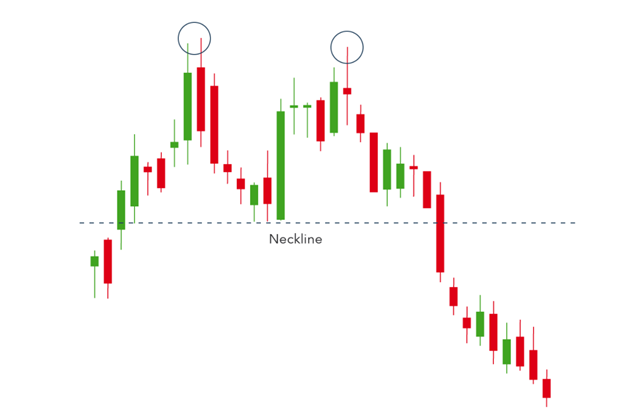
It is one more pattern that traders make use of to show trend withdrawals. Generally, a holding’s cost would undergo a peak, previous to returning to support level. It will later rise once again before shifting back ever next to the general trend.
This pattern is very much similar to the H&S chart pattern with 2 peaks showing that the purchaser’s concern has declined with the possibility of a downwards shift.
Double bottom- Often used chart pattern by trader
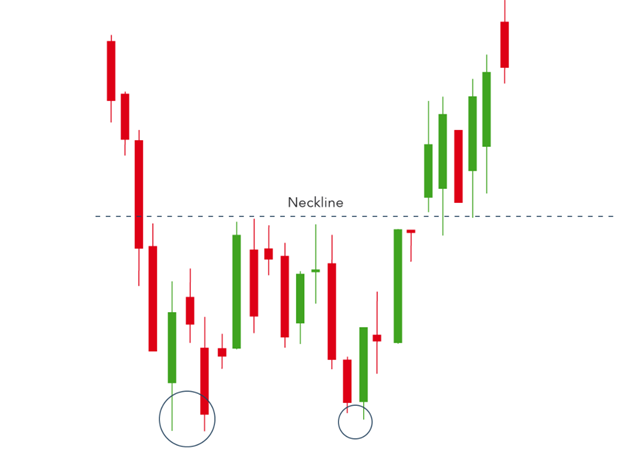
This chart pattern shows a selling period, making an asset’s cost fall under the support level. It would then grow to a resistance level, previous to falling once more. In the end, the trend would shift and start an upward movement since the market turns out very bullish.
A double bottom pattern is a bullish withdrawal pattern as it implies the termination of a downtrend and a turn close to an uptrend. This pattern has 2 reduced price gaps which foretell an upward trend because buyer concern gets aroused.
Rounding bottom- The best chart pattern ever
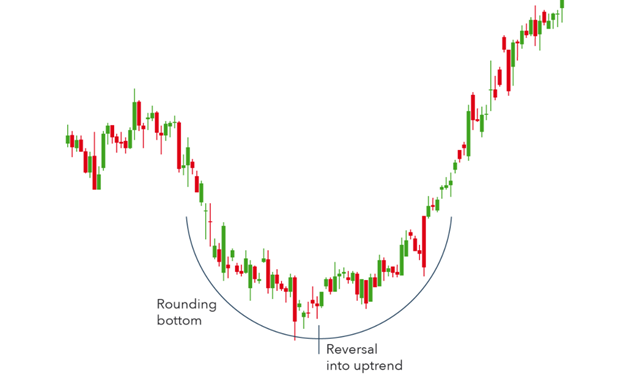
This chart pattern in forex can imply a correction or a withdrawal. Say, all through an uptrend a holding’s price can drop back somewhat previous to growing once again. This will be like a bullish correction.
An instance of a bullish withdrawal rounding base will be if a holding’s price was in a downtrend and a rounding base created previous to the trend changed and got into a bullish uptrend.
Traders would try to gain on this pattern through buying almost nearby the base, at the flat end, and gaining on the restoration once it occurs above a resistance level.
Cup and handle- One more significant chart pattern
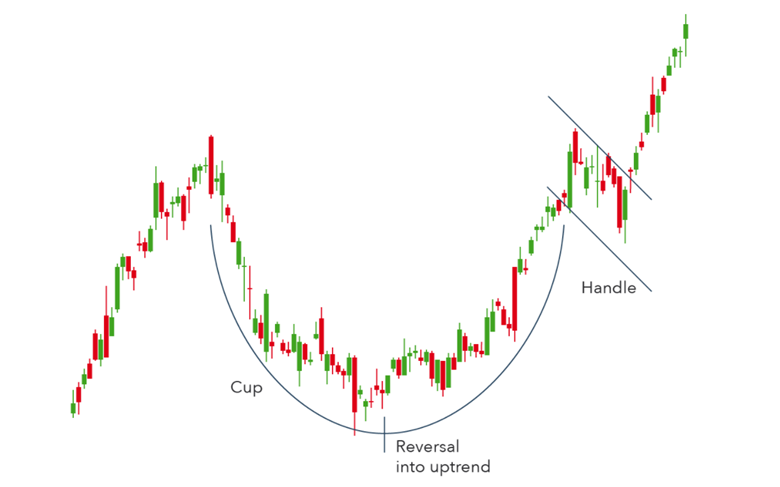
This chart pattern is a bullish sequence pattern that is generally used to confirm a time of bearish market view previous to the complete trend, in the end, stays in a bullish movement. The cup appears similar to a rounding bottom. Also, the handle is like a wedge chart pattern.
Going after wing the rounding bottom pattern, the cost of a holding would possibly get into a short retracement, which is usually called the handle as this retracement gets limited to 2 lateral lines on the price chart. The holding or asset would finally shift outside of the handle and move ahead with the complete bullish inclination.
Wedges chart patterns
Wedges emerge as the price of asset modifies stretch within 2 diverging trend lines. There are two sets of wedges like rising or growing and falling wedges.
A rising or growing wedge is usually exhibited through a trend line interposed in two upward diverging formations of resistance and support.
In this condition, the support line is more perpendicular than the line of resistance. This chart pattern usually indicates that a holding’s price would finally drop more lastingly– which is then exhibited when it is discontinued via the support level.
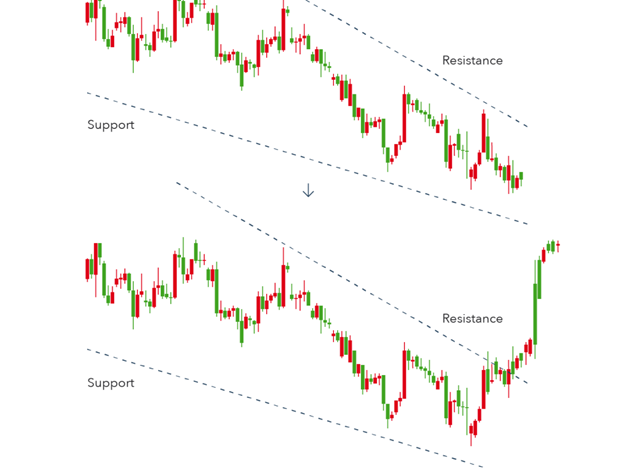
Any other way, a falling wedge takes place within two downward oblique levels. In this condition, the resistance line is sheerer than the support level. A falling wedge is generally suggestive that a holding’s price would grow and break via the resistance level, as described in the instance here.
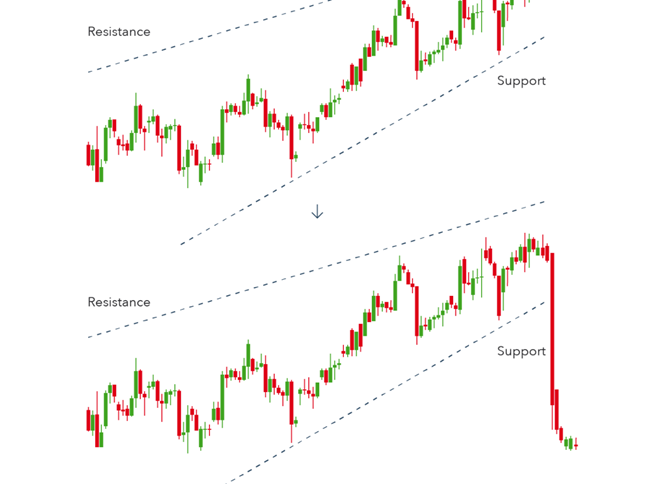
Both the wedges are withdrawal patterns, with rising or growing wedges showing a bearish exchange and falling or dropping wedges implying more common of a bullish exchange.
Also, the wedge doesn’t involve an upward break because of both trendlines going down. One more differentiation is that the more superficial slopes show a long-term chart pattern when correlated with the triangle patterns.
Pennant or flags chart patterns
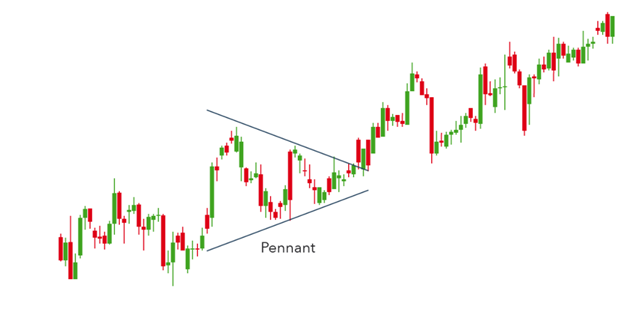
Pennant or flags chart patterns are generally created later when an asset undergoes a phase of upward change, accompanied by a union. Usually, there would be a notable growth all through the early phases of the trend, before it gets into a set of more petite downward and upward changes.
These patterns may seem bearish or bullish. Also, they may show a sequence or a withdrawal. The above pattern is an instance of a bullish correction. In this regard, pennant patterns can be a kind of bilateral chart pattern as they depict corrections or withdrawals.
Whereas a pennant may appear like a triangle pattern or wedge pattern– it is significant to observe that wedges are more precarious than triangles or pennants. As well as wedges vary from pennants since a wedge is ever descending or ascending, whereas a pennant is ever parallel.
Ascending and descending chart patterns
This pattern is a bullish improvement pattern that depicts the chain of an upward trend. These patterns can be then moved onto charts by keeping a parallel line together with the motion highs and then forming an ascending course together with the motion lows.
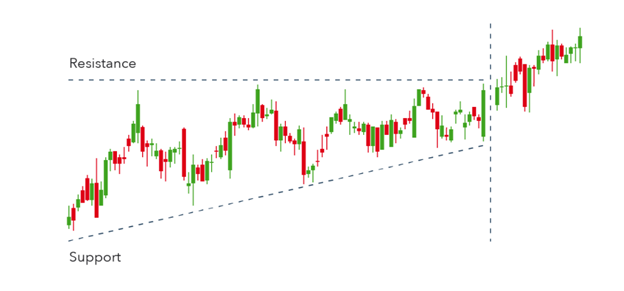
Ascending triangle patterns usually have 2 or more similar peak highs that let the parallel line get formed. The trend pattern means the complete uptrend of the chart pattern. Whereas the parallel line shows the historic resistance level for that specific asset.
In the analysis, a descending pattern depicts a bearish improvement of a downward trend. Usually, a trader would get into a short trade position all through a descending or falling triangle pattern, which is in a try to generate profit from a declining market.
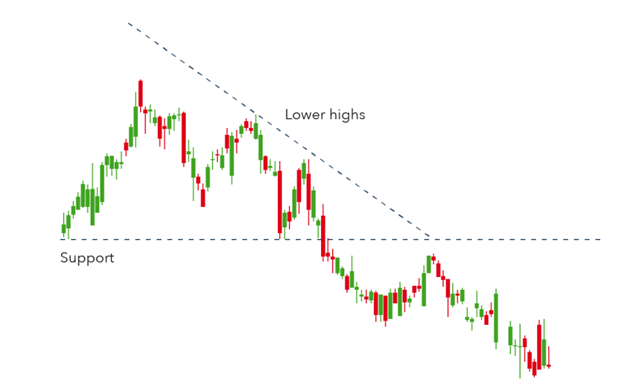
Descending or declining triangles usually move below and break via the support as they are symbolic of a market controlled by sellers, signifying that together under peaks are possible to be prevailing and absurd to shift.
These patterns can be generally distinguished from a parallel support line and a downward-slanting resistance line. Finally, the trend would break via support, and the downward trend would resume.
Symmetrical triangle- Essential chart patterns
This pattern can be bearish or bullish, based on the market. In each case, it is often a correction pattern, which signifies the market would stay in the same way as the whole trend when the chart pattern was created.
Symmetrical triangle patterns are generally formed when the price combines with a set of weaker peaks and stronger troughs. In the instance given below, there is a bearish trend. But the symmetrical triangle pattern depicts us that there has been an abrupt upward reversal period.
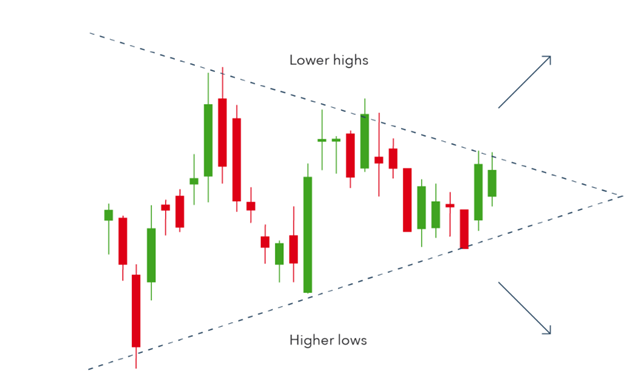
Yet, if there is no explicit trend previous to the triangle chart pattern creation, the market can break out in each way. This produces balanced triangles into a 2 sided pattern. Thus, signifying that they are very well used in volatile markets where there’s no explicit sign of which direction a holding’s price can shift. You can look at 2 sided symmetrical triangle chart patterns below.

Engulfing Chart Patterns
Engulfing chart patterns are an outstanding trading chance since they can be very well recognized and the price activity exhibits a powerful and quick shift in direction. In a downward trend, and up-dip actual body would ultimately cover the previous down-dip actual body (bullish covering). In an upward trend, a down-dip actual body would ultimately cover the previous up-dip actual body (bearish covering).
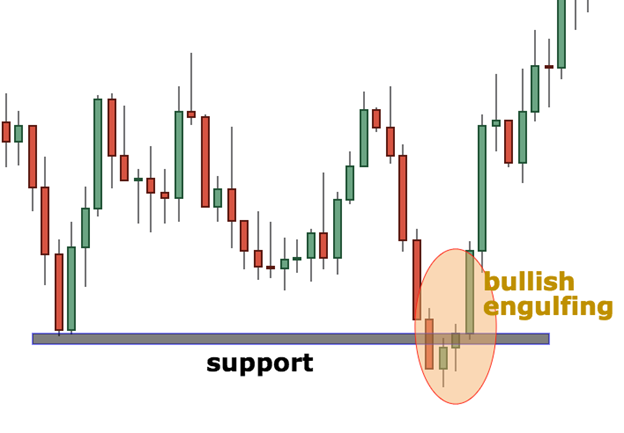
Final words about top 10 most commonly used forex chart patterns
All the above top 10 most commonly used chart patterns in forex are helpful technical pointers that can assist you in knowing how or why a holding’s price shifted in a definite way – and in which direction it will shift in the future. This is due to forex chart patterns being able to show regions of resistance and support, which may assist a trader in deciding even if they should go for a long or short trade position; or they must finish their open trade positions in the occurrence of a potential trend refusal.
References: https://www.forexlive.com/Education/!/trading-with-the-5-most-popular-forex-chart-patterns-01-20170418
https://www.investopedia.com/articles/forex/11/most-used-forex-patterns.asp
Disclaimer: This material is a marketing communication and shall not in any case be construed as an investment advice, investment recommendation or presentation of an investment strategy. The marketing communication is prepared without taking into consideration the individual investors personal circumstances, investment experience or current financial situation. Any information contained therein in regardsto past performance or future forecasts does not constitute a reliable indicator of future performance, as circumstances may change over time. Scope Markets shall not accept any responsibility for any losses of investors due to the use and the content of the abovementioned information. Please note that forex trading and trading in other leveraged products involves a significant level of risk and is not suitable for all investors.







